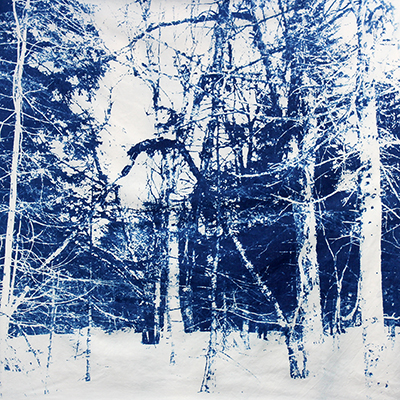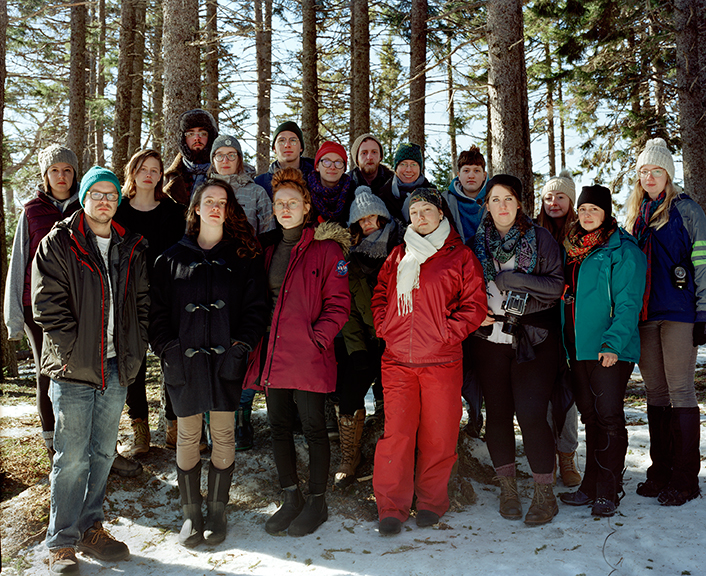Into the Woods
 Picture yourself on a peaceful hike through Fundy National Park and coming upon a large photo printed on white cotton material, depicting a blue and white winter forest scene. It’s hanging from a rope attached to a tree. A closer look reveals the image is positioned very closely to where it was created months before. The difference is, the real-life image beyond the photo is no longer a winter scene, but the same view in summer blossom.
Picture yourself on a peaceful hike through Fundy National Park and coming upon a large photo printed on white cotton material, depicting a blue and white winter forest scene. It’s hanging from a rope attached to a tree. A closer look reveals the image is positioned very closely to where it was created months before. The difference is, the real-life image beyond the photo is no longer a winter scene, but the same view in summer blossom.
“My intention is to offer park visitors an interpretive glimpse into what the trail looks like in the off-season,” says fourth-year Fine Arts student Savannah Harris, who created the work. “With this directed view, I hope that visitors will take the time to become more aware of their surroundings.”
Harris created the photos in January, when she hiked the entirety of the East Branch trail as part of the course Studies in Site and Place. She placed the resulting nine cyanotype images along the same trail in June in a site-specific photography installation.
 Studies in Site and Place is Mount Allison’s contribution to the nationwide LandMarks2017 initiative, in celebration of Canada’s 150th anniversary. Mount Allison is one of 16 universities across the country taking part in the project, which is led by faculty in collaboration with curators and artists. The initiative took students out of the classroom and the studio to create multidisciplinary works of art and at the same time connect with the natural world.
Studies in Site and Place is Mount Allison’s contribution to the nationwide LandMarks2017 initiative, in celebration of Canada’s 150th anniversary. Mount Allison is one of 16 universities across the country taking part in the project, which is led by faculty in collaboration with curators and artists. The initiative took students out of the classroom and the studio to create multidisciplinary works of art and at the same time connect with the natural world.
“Studies in Site and Place is about drawing on local resources to enrich student experiences and putting a focus on local landscapes,” says Karen Stentaford (’99), photography technician and lecturer in the Fine Arts department, who teaches the course. She arranged a day-long site visit to Fundy National Park in January with the students and a three-day overnight work session in March.
“We really wanted to challenge students in the ways they typically research and work. As part of the course we had an Indigenous elder come in and speak to students about a different history and relationship to the land. We also had urban planners talk to them about the idea of place-making and site-specific artwork and how they relate to the environment,” she says.
The students’ creative work was on exhibit from June 10-25 in Fundy National Park and is featured on Landmarks2017.ca — giving these emerging artists the rare opportunity to engage in a shared national art curriculum.
“Taking 15 students out of the classroom and seeing the way they connect to the natural world, how their personal history directs how they work, and the diverse outcomes that result has been pretty amazing,” Stentaford says. “Prior to this course, some of the students had never been to a park like Fundy and it has provided them with the opportunity to respond creatively to landscapes they haven’t experienced before.”
The student-artists worked with David Diviney, curator of modern and contemporary art at the Art Gallery of Nova Scotia, along with Fundy National Park staff.
“The staff at Fundy are so very accommodating of our ideas and the students. This experience is a strong model for our continued partnership with Fundy,” says Stentaford.


